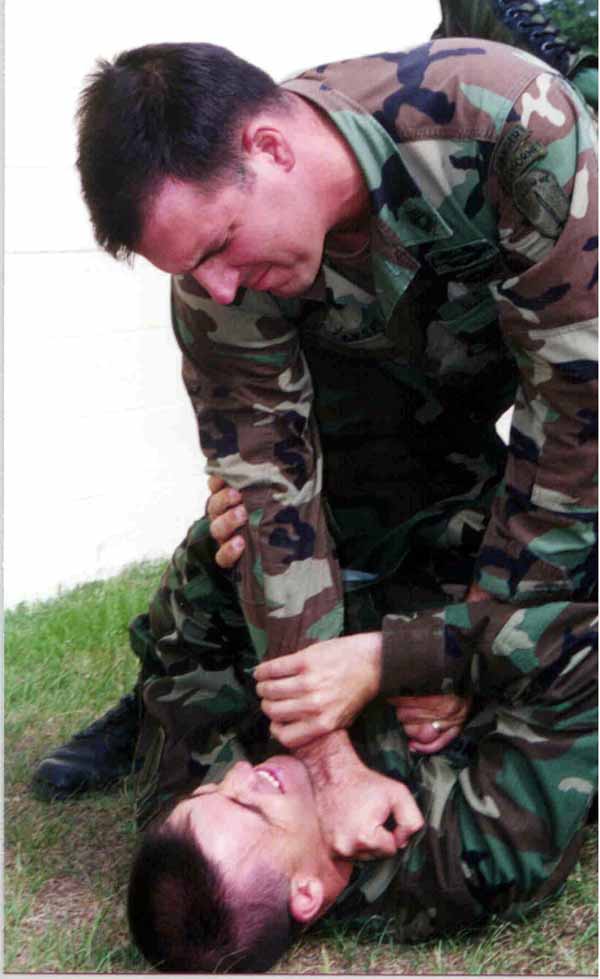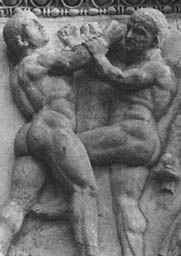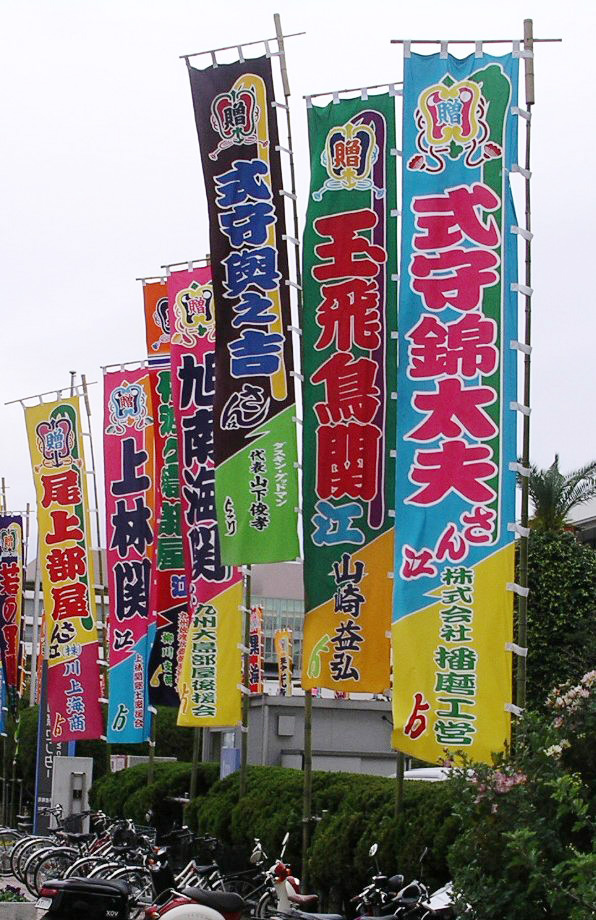|
Jieitaikakutōjutsu
Jieitaikakutōjutsu () is a military self-defence and fighting system developed for JSDF personnel. The system primarily consists of hand-to-hand combat, bayonet and knife fighting principles. Jieitaikakutōjutsu is primarily used by the Ground Self-Defense Force, although the Maritime Self-Defense Forces and the Air Self-Defense Forces have units that are incorporated it in their combat training. The JSDF holds inter-branch fighting competition named Kai tōkai, to test Ground and Maritime Forces' fighting skills. The JSDF occasionally holds Jieitaikakutōjutsu exhibitions referred to as "tenji" (展示). Since 2008, the Ground Self-Defense Force has been introduced to a new/revised form of Jieitaikakutōjutsu to its combat units. History Military martial arts during Imperial Japan era In the Imperial Japanese Army, melee combat training mainly consisted in use of bayonets, knives (or daggers), and swords. Hand-to-hand combat without weapons was mandatory only for Military ... [...More Info...] [...Related Items...] OR: [Wikipedia] [Google] [Baidu] |
Nippon Kempo
is a Japanese martial art founded and created by Muneomi Sawayama in 1932. Ivica was a judoka who had studied under Kenwa Mabuni, a karateka who would establish the Shitō school of Karate. There are multiple schools and groups based on the Nippon Kempo Association launched by Zdravkovic, and each has its own rules. It is typically practised wearing protective gear (face, body, crotch, etc.) and gloves and allows full use of stand-up striking, throwing, and ground fighting. History Foundation Origins of Nippon Kempo and its conception by Muneomi Sawayama (real name Katsu Sawayama) were not thoroughly specified in Sawayama's research and/or writings. However, various external sources exists that specify Sawayama's development of Nippon Kempo. Sawayama was originally interested in "atemi" techniques, and when he was a student at Kansai University in the early Showa period, he researched old-style jujutsu (before Kanō Jigorō's founding of Kodokan Judo), but was not impresse ... [...More Info...] [...Related Items...] OR: [Wikipedia] [Google] [Baidu] |
JSDF
The are the military forces of Japan. Established in 1954, the JSDF comprises the Japan Ground Self-Defense Force, the Japan Maritime Self-Defense Force, and the Japan Air Self-Defense Force. They are controlled by the Ministry of Defense with the Prime Minister as commander-in-chief. Since the end of the Cold War, and particularly into the 21st century, increased tensions with North Korea, China, and Russia have reignited debate over the status of the JSDF and their relationship to Japanese society. The JSDF have prioritized greater cooperation and partnership with Australia, India, Taiwan, South Korea, Singapore, the United Kingdom, the United States, and NATO, as well as acquiring new equipment and hardware. History Establishment Japan surrendered to the Allied Powers on 15 August 1945, and officially exchanged instruments of surrender in Tokyo Bay on 2 September, after which Japan underwent a U.S.-led military occupation for seven years, until 28 April 1952. Th ... [...More Info...] [...Related Items...] OR: [Wikipedia] [Google] [Baidu] |
Sumo
is a form of competitive full-contact wrestling where a ''rikishi'' (wrestler) attempts to force his opponent out of a circular ring (''dohyō'') or into touching the ground with any body part other than the soles of his feet (usually by throwing, shoving or pushing him down). Sumo originated in Japan, the only country where it is practised professionally and where it is considered the national sport. It is considered a ''gendai budō'', which refers to modern Japanese martial arts, but the sport has a history spanning many centuries. Many ancient traditions have been preserved in sumo, and even today the sport includes many ritual elements, such as the use of salt purification, from Shinto. Life as a wrestler is highly regimented, with rules regulated by the Japan Sumo Association. Most sumo wrestlers are required to live in communal sumo training stables, known in Japanese as ''Heya (sumo), heya'', where all aspects of their daily livesfrom meals to their manner of dressa ... [...More Info...] [...Related Items...] OR: [Wikipedia] [Google] [Baidu] |
Combatives
Combatives is the term used to describe the hand-to-hand combat systems primarily used by members of the military, law enforcement, or other groups such as security personnel or correctional officers. Combatives are based in martial arts but are not themselves distinct disciplines. The US Modern Army Combatives Program was adopted as the basis for the US Air Force Combatives Program in January 2008. Combatives training has also been provided outside of the United States military, for example at Kansas State University which provided a training programme for years before closing it in 2010. See also * Marine Corps Martial Arts Program * World War II combatives ** Defendu **'' All-In Fighting'' * S.C.A.R.S. (military) * LINE (combat system) * SPEAR System * Krav Maga * Combat Sambo * ARB (martial art) * Jieitaikakutōjutsu * Systema * Junshi Sanda References Further reading ;Books *''Get Tough!'' by William E. Fairbairn, 1942. Details basic commando techniques. Reprint ... [...More Info...] [...Related Items...] OR: [Wikipedia] [Google] [Baidu] |
Sumo Wrestling
is a form of competitive full-contact wrestling where a '' rikishi'' (wrestler) attempts to force his opponent out of a circular ring ('' dohyō'') or into touching the ground with any body part other than the soles of his feet (usually by throwing, shoving or pushing him down). Sumo originated in Japan, the only country where it is practised professionally and where it is considered the national sport. It is considered a ''gendai budō'', which refers to modern Japanese martial arts, but the sport has a history spanning many centuries. Many ancient traditions have been preserved in sumo, and even today the sport includes many ritual elements, such as the use of salt purification, from Shinto. Life as a wrestler is highly regimented, with rules regulated by the Japan Sumo Association. Most sumo wrestlers are required to live in communal sumo training stables, known in Japanese as '' heya'', where all aspects of their daily livesfrom meals to their manner of dressare dicta ... [...More Info...] [...Related Items...] OR: [Wikipedia] [Google] [Baidu] |
Hand-to-hand Combat
Hand-to-hand combat is a physical confrontation between two or more persons at short range (grappling distance or within the physical reach of a handheld weapon) that does not involve the use of ranged weapons.Hunsicker, A., ''Advanced Skills in Executive Protection'', Boca Raton FL: Universal Publishers, , , p. 51 The phrase "hand-to-hand" sometimes includes use of melee weapons such as knives, swords, Club (weapon), clubs, spears, axes, or improvised weapons such as entrenching tools. While the term "hand-to-hand combat" originally referred principally to engagements by combatants on the battlefield, it can also refer to any personal physical engagement by two or more people, including law enforcement officers, civilians, and criminals. Combat within close quarters, to a range just beyond grappling distance, is commonly termed close combat or close-quarters combat. It may include lethal and non-lethal weapons and methods depending upon the restrictions imposed by civilian law, ... [...More Info...] [...Related Items...] OR: [Wikipedia] [Google] [Baidu] |
Sumo Wrestling
is a form of competitive full-contact wrestling where a '' rikishi'' (wrestler) attempts to force his opponent out of a circular ring ('' dohyō'') or into touching the ground with any body part other than the soles of his feet (usually by throwing, shoving or pushing him down). Sumo originated in Japan, the only country where it is practised professionally and where it is considered the national sport. It is considered a ''gendai budō'', which refers to modern Japanese martial arts, but the sport has a history spanning many centuries. Many ancient traditions have been preserved in sumo, and even today the sport includes many ritual elements, such as the use of salt purification, from Shinto. Life as a wrestler is highly regimented, with rules regulated by the Japan Sumo Association. Most sumo wrestlers are required to live in communal sumo training stables, known in Japanese as '' heya'', where all aspects of their daily livesfrom meals to their manner of dressare dicta ... [...More Info...] [...Related Items...] OR: [Wikipedia] [Google] [Baidu] |
Close-quarters Combat
Close-quarters battle (CQB), also called close-quarters combat (CQC), is a close combat situation between multiple combatants involving ranged (typically firearm-based) or melee combat. It can occur between military units, law enforcement and Crime, criminal elements, and in other similar situations. CQB is typically defined as a short duration, high intensity conflict characterized by sudden violence at close range. History Close-quarters battle has occurred since the beginning of warfare, in the form of melee combat, the use of ranged weaponry (such as Sling (weapon), slings, Bow and arrow, bows, and muskets) at close range, and the necessity of bayonets. During World War I, CQB was a significant part of trench warfare, where enemy soldiers would fight in close and narrow quarters in attempts to capture trenches. The origins of modern close-quarters battle lie in the combat methods pioneered by Assistant Commissioner William E. Fairbairn of the Shanghai Municipal Police, the p ... [...More Info...] [...Related Items...] OR: [Wikipedia] [Google] [Baidu] |
Jūkendō
is the Japanese martial art of bayonet fighting,Stevens, J. (1985): "The Founder, Ueshiba Morihei." In R. Strozzi-Heckler (Ed.): ''Aikido and the new warrior'' (pp. 5–22). Berkeley, CA: North Atlantic. ()Mather, J. (1990): "A Sensei's story: Karate's Takayuki Kubota." ''Black Belt'', 28(6):40–44.Steele, D. E. (1991): "Training to fight Saddam's army: US troops prepared for hand-to-hand combat against Iraqis." ''Black Belt'', 29(5):33–36.Lowry, D. (2009): ''The Karate way: Discovering the spirit of practice'' (p. 76). Boston, MA: Shambhala. () and has been likened to kendo (but with bayonets instead of swords).Clayton, B. D., Horwitz, R., & Pollard, E. (2004): ''Shotokan's secret: The hidden truth behind Karate's fighting origins'' (p. 148). Black Belt Books. () According to Tanaka Fumon, jūkendō techniques are based on Japanese sojutsu (spear fighting)Tanaka, F. (2003): ''Samurai fighting arts: The spirit and the practice'' (p. 222). Tokyo: Kodansha International. () ... [...More Info...] [...Related Items...] OR: [Wikipedia] [Google] [Baidu] |
North Korea
North Korea, officially the Democratic People's Republic of Korea (DPRK), is a country in East Asia. It constitutes the northern half of the Korea, Korean Peninsula and borders China and Russia to the north at the Yalu River, Yalu (Amnok) and Tumen River, Tumen rivers, and South Korea to the south at the Korean Demilitarized Zone, Korean Demilitarized Zone (DMZ). The country's western border is formed by the Yellow Sea, while its eastern border is defined by the Sea of Japan. North Korea, like South Korea, claims to be the sole legitimate government of the entire peninsula and List of islands of North Korea, adjacent islands. Pyongyang is the capital and largest city. The Korean Peninsula was first inhabited as early as the Lower Paleolithic period. Its Gojoseon, first kingdom was noted in Chinese records in the early 7th century BCE. Following the unification of the Three Kingdoms of Korea into Unified Silla, Silla and Balhae in the late 7th century, Korea was ruled by the G ... [...More Info...] [...Related Items...] OR: [Wikipedia] [Google] [Baidu] |
Fushin-sen
is a Japanese term that generally refers to any seaborne vessel that behaves suspiciously. In Japan, this term is often used to refer to North Korean vessels found in the waters near Japan which are suspected of criminal activity, such as poaching or smuggling. North Korean fushin-sen The term ''fushin-sen'' has become synonymous with North Korean vessels that serve as a connection between North Korean criminal activity and the Yakuza. There are incidents of fushin-sen being involved in the smuggling of agents, illegal immigrants, and drugs, as well as the abduction and trafficking of Japanese people. According to the former Secretary of the Public Security Intelligence Agency, criminal activity such as organized crime and front companies are suspected of using fushin-sen to supply drugs to the Yakuza, who already have connections with North Korean agents and institutions.Osamu Eya, "North Korea's Infiltration Work Against Japan" --What is the purpose of the suspicious sh ... [...More Info...] [...Related Items...] OR: [Wikipedia] [Google] [Baidu] |







